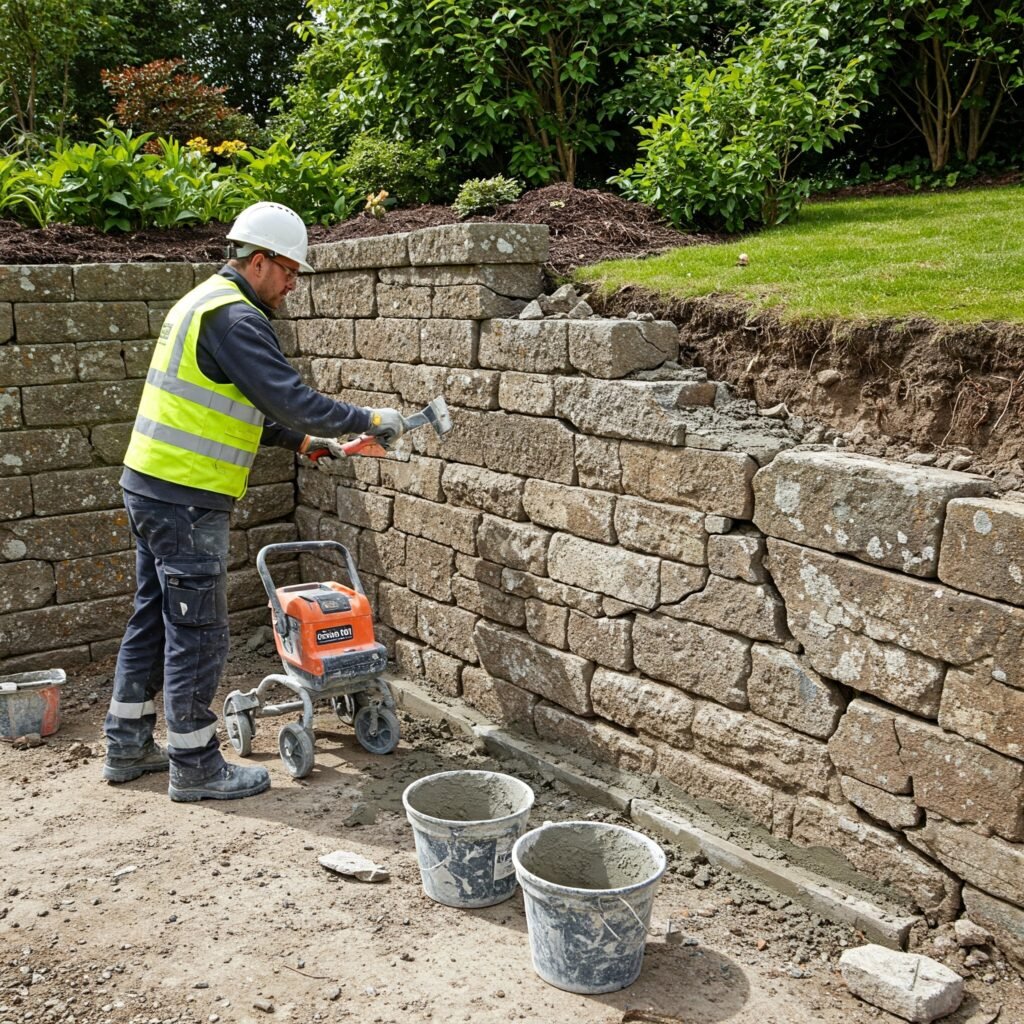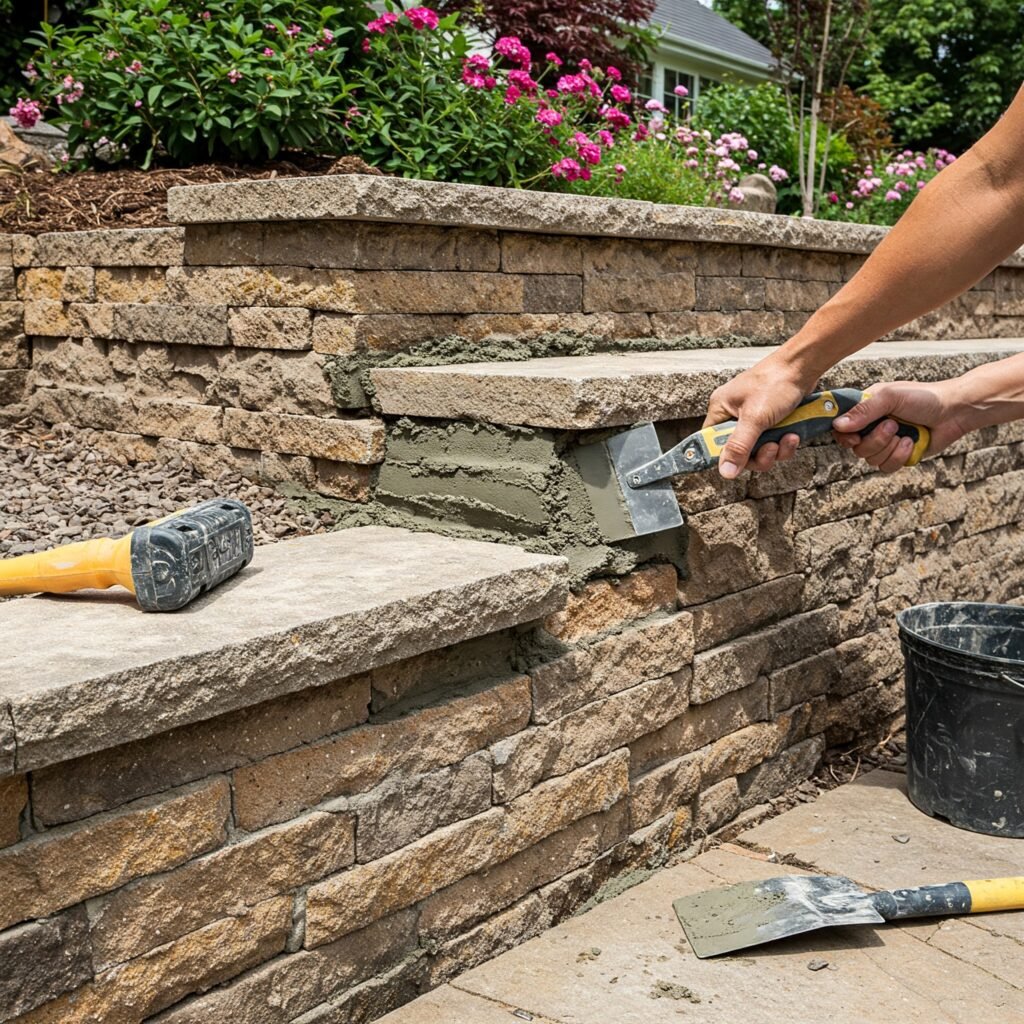Repairing a retaining wall is an important process for preserving the functionality and safety of your landscape. A well-maintained retaining wall holds back soil, prevents erosion, and protects your property. When signs of damage appear—such as cracks, leaning, or water seepage—it’s critical to address them early. In this guide, we’ll explore nine reliable methods for repairing a retaining wall. These practical solutions are designed for homeowners seeking to understand repair techniques, causes of damage, and best practices for maintenance.
Why Repairing a Retaining Wall Is Essential
Repairing a retaining wall promptly ensures that your structure remains stable and continues to perform its intended purpose. Retaining walls support sloped terrain, prevent landslides, and create usable outdoor spaces. If neglected, even small issues can evolve into costly repairs or potential structural failure.
Understanding Common Causes of Retaining Wall Failure
To effectively approach repairing a retaining wall, it’s helpful to know what typically causes damage. Some of the most common factors include:
- Hydrostatic pressure from poor drainage
- Inadequate reinforcement or anchoring
- Material deterioration over time due to weather exposure
- Tree roots or underground movements
Recognizing the root causes helps you choose the most appropriate repair method.
1. Reinforcing a Retaining Wall with Tiebacks
Tiebacks are long rods or cables anchored in the soil behind a wall. They provide additional lateral support to prevent a retaining wall from leaning further.
How it works:
- Drill holes through the wall at specific intervals
- Insert steel rods into the soil and secure with anchors
- Tighten the rods to straighten and stabilize the wall
This technique is commonly used for taller walls or walls built on slopes with high soil pressure.
2. Rebuilding Damaged Sections with Concrete Blocks
When certain portions of the wall are too deteriorated, partial rebuilding is often the best solution.
Repair steps:
- Dismantle the damaged section
- Prepare a solid gravel base for stability
- Rebuild using interlocking concrete blocks or new stones
- Ensure proper leveling and alignment during reconstruction
Rebuilding improves the structural integrity and longevity of the wall.
3. Improving Drainage to Reduce Pressure
One of the key reasons for retaining wall damage is poor drainage. Water accumulation behind the wall increases pressure and can lead to cracks or collapse.
Drainage improvement options include:
- Weep holes: Small openings at the bottom of the wall to let water escape
- Drainage pipes: Perforated pipes laid behind the wall, covered with gravel
- Gravel backfill: Helps water move away from the wall quickly
Proper drainage is a long-term preventive measure when repairing a retaining wall.

4. Reinforcing with Carbon Fiber Straps
For walls with moderate cracks or bulging, carbon fiber straps offer a lightweight and minimally invasive solution.
Installation process:
- Clean and smooth the wall surface
- Apply epoxy resin and press the carbon fiber straps into place
- Allow adequate curing time
These straps are durable and can be painted over for aesthetic consistency.
5. Applying Shotcrete for Surface Restoration
Shotcrete is a form of concrete sprayed onto surfaces at high velocity. It’s useful for repairing large areas where wall surfaces have spalled or deteriorated.
Steps involved:
- Prepare the surface by removing loose debris
- Apply shotcrete using specialized equipment
- Smooth and cure the material as needed
This technique restores the appearance and functionality of a retaining wall.
6. Replacing Backfill Material and Landscape Fabric
Clogged or compacted backfill and fabric behind the wall can hinder proper drainage and lead to damage.
Replacement guide:
- Excavate the soil behind the wall
- Remove and discard old or compacted material
- Lay down new landscape fabric
- Add fresh, coarse gravel and tamp it down for stability
Regular maintenance of the backfill system supports long-term wall health.
7. Reconstructing a Retaining Wall When Necessary
If damage is extensive and beyond repair, rebuilding the wall is the most secure option. This is especially true when the foundation has shifted or the wall shows widespread instability.
Reconstruction tips:
- Use high-quality, weather-resistant materials
- Incorporate modern construction techniques like geogrids or reinforced concrete
- Ensure proper drainage and soil compaction
- Hire professional help if the wall exceeds 4 feet in height
Though more labor-intensive, a rebuilt wall can offer decades of reliable performance.
8. Sealing Cracks and Waterproofing the Wall
Minor cracks can lead to bigger problems if not sealed properly. Waterproof sealants and crack fillers can be used to prevent water infiltration.
Application tips:
- Clean the surface and clear debris from the cracks
- Use a concrete crack filler or sealant
- Apply waterproofing membrane or paint to protect the entire wall
This step adds durability and prolongs the life of the wall.
9. Installing Drainage Boards or Mats
To further manage moisture, drainage boards or mats can be installed behind retaining walls. These systems direct water down to the base, reducing pressure.
How it helps:
- Prevents water accumulation
- Maintains backfill drainage
- Works well with weep holes and piping systems
Combining this with other drainage solutions ensures comprehensive protection.

Maintaining Your Retaining Wall Post-Repair
Once you’ve completed repairing a retaining wall, consistent maintenance is key. Here are some best practices:
- Inspect the wall regularly for cracks, tilting, or water seepage
- Clear vegetation growing too close to the structure
- Maintain drainage systems to avoid water buildup
- Avoid overloading the top of the wall with heavy equipment or landscaping
With routine care, a repaired retaining wall can function effectively and remain visually appealing for many years.
Final Thoughts: Taking the Right Steps in Repairing a Retaining Wall
Repairing a retaining wall involves more than just fixing visible damage. It requires identifying the cause of failure, selecting the correct method, and taking preventive actions. Whether you’re reinforcing with tiebacks, restoring with shotcrete, or rebuilding entirely, the goal is to create a safe and lasting solution.
By understanding these nine methods and applying them properly, homeowners can save money, enhance their property’s appearance, and protect their landscape investment. Don’t hesitate to seek professional advice for complex repairs or tall structures. Your retaining wall is an essential part of your outdoor space—keep it strong and reliable through informed, proactive care.

Pingback: How to Remove Drywall Anchors - 9 Damage-Free Methods
Pingback: HOW WE BUY HOUSES IN ANY CONDITION SAVES TIME AND MONEY FOR CHATTANOOGA HOMEOWNERS - hayathomeessentials.com
Pingback: Essential Maintenance and Repair Tips from Agendacoverlife.com - hayathomeessentials.com
Pingback: Black and White Backsplash Ideas - Timeless Kitchen Designs"